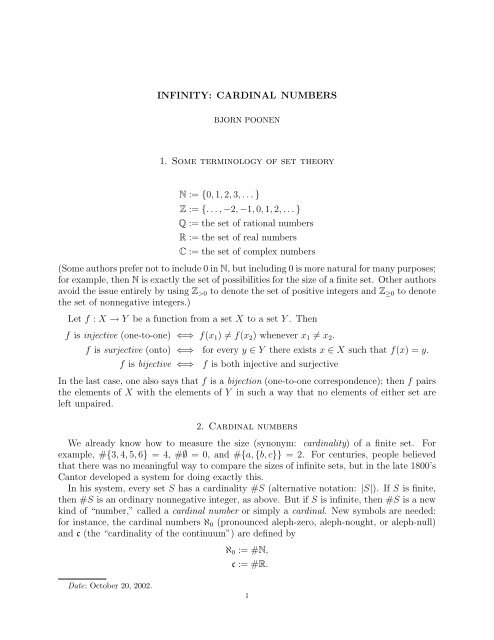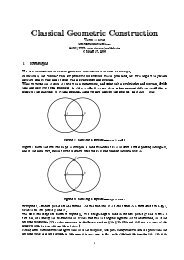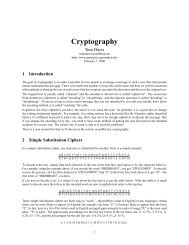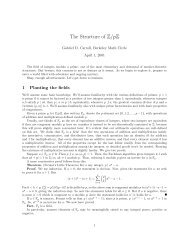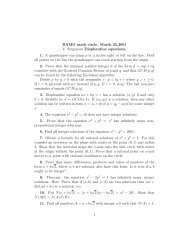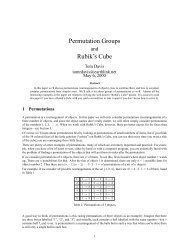INFINITY: CARDINAL NUMBERS 1. Some terminology of set theory ...
INFINITY: CARDINAL NUMBERS 1. Some terminology of set theory ...
INFINITY: CARDINAL NUMBERS 1. Some terminology of set theory ...
You also want an ePaper? Increase the reach of your titles
YUMPU automatically turns print PDFs into web optimized ePapers that Google loves.
<strong>INFINITY</strong>: <strong>CARDINAL</strong> <strong>NUMBERS</strong><br />
BJORN POONEN<br />
<strong>1.</strong> <strong>Some</strong> <strong>terminology</strong> <strong>of</strong> <strong>set</strong> <strong>theory</strong><br />
N := {0, 1, 2, 3, . . . }<br />
Z := {. . . , −2, −1, 0, 1, 2, . . . }<br />
Q := the <strong>set</strong> <strong>of</strong> rational numbers<br />
R := the <strong>set</strong> <strong>of</strong> real numbers<br />
C := the <strong>set</strong> <strong>of</strong> complex numbers<br />
(<strong>Some</strong> authors prefer not to include 0 in N, but including 0 is more natural for many purposes;<br />
for example, then N is exactly the <strong>set</strong> <strong>of</strong> possibilities for the size <strong>of</strong> a finite <strong>set</strong>. Other authors<br />
avoid the issue entirely by using Z>0 to denote the <strong>set</strong> <strong>of</strong> positive integers and Z≥0 to denote<br />
the <strong>set</strong> <strong>of</strong> nonnegative integers.)<br />
Let f : X → Y be a function from a <strong>set</strong> X to a <strong>set</strong> Y . Then<br />
f is injective (one-to-one) ⇐⇒ f(x1) = f(x2) whenever x1 = x2.<br />
f is surjective (onto) ⇐⇒ for every y ∈ Y there exists x ∈ X such that f(x) = y.<br />
f is bijective ⇐⇒ f is both injective and surjective<br />
In the last case, one also says that f is a bijection (one-to-one correspondence); then f pairs<br />
the elements <strong>of</strong> X with the elements <strong>of</strong> Y in such a way that no elements <strong>of</strong> either <strong>set</strong> are<br />
left unpaired.<br />
2. Cardinal numbers<br />
We already know how to measure the size (synonym: cardinality) <strong>of</strong> a finite <strong>set</strong>. For<br />
example, #{3, 4, 5, 6} = 4, #∅ = 0, and #{a, {b, c}} = 2. For centuries, people believed<br />
that there was no meaningful way to compare the sizes <strong>of</strong> infinite <strong>set</strong>s, but in the late 1800’s<br />
Cantor developed a system for doing exactly this.<br />
In his system, every <strong>set</strong> S has a cardinality #S (alternative notation: |S|). If S is finite,<br />
then #S is an ordinary nonnegative integer, as above. But if S is infinite, then #S is a new<br />
kind <strong>of</strong> “number,” called a cardinal number or simply a cardinal. New symbols are needed:<br />
for instance, the cardinal numbers ℵ0 (pronounced aleph-zero, aleph-nought, or aleph-null)<br />
and c (the “cardinality <strong>of</strong> the continuum”) are defined by<br />
Date: October 20, 2002.<br />
ℵ0 := #N,<br />
c := #R.<br />
1
2 BJORN POONEN<br />
3. Equality <strong>of</strong> cardinal numbers<br />
We do not introduce a different symbol for every individual <strong>set</strong>, because sometimes two<br />
different <strong>set</strong>s can have the same size. For instance, two finite <strong>set</strong>s have the same size if<br />
and only if one <strong>set</strong> can be obtained from the other by relabeling the elements; for instance,<br />
{1, 2, 3} has the same cardinality as {a, b, c}. One <strong>of</strong> the fundamental properties <strong>of</strong> Cantor’s<br />
cardinal numbers is that the same should hold for arbitrary <strong>set</strong>s, finite or not. This can be<br />
reworded as follows:<br />
RULE 1: #S = #T ⇐⇒ there exists a bijection f : S → T .<br />
For instance, if S = {0, −1, −2, −3, . . . }, then #N = #S because there is a bijection<br />
N → S sending each nonnegative integer n to −n:<br />
0 ←→ 0<br />
1 ←→ −1<br />
2 ←→ −2<br />
3 ←→ −3<br />
.<br />
4. Comparing cardinal numbers<br />
RULE 2: #S ≤ #T ⇐⇒ there exists an injection f : S → T .<br />
Loosely speaking, S is smaller or equal in size to T if and only if one can match the elements<br />
<strong>of</strong> S with elements <strong>of</strong> T so that all elements <strong>of</strong> S get used (but maybe some elements <strong>of</strong> T<br />
are left over). For example, there is an injection {a, b, c} → N sending a to 1, b to 2, and c<br />
to 17; this proves that 3 ≤ ℵ0. As a special case <strong>of</strong> Rule 2, if S ⊆ T , then #S ≤ #T .<br />
The relations = and ≤ for cardinals satisfy the same properties as they do for ordinary<br />
numbers:<br />
(1) #S = #S for any <strong>set</strong> S (reflexivity).<br />
(2) If #S = #T , then #T = #S (symmetry).<br />
(3) If #S = #T and #T = #U, then #S = #U (transitivity).<br />
(4) If #S = #T , then #S ≤ #T .<br />
(5) If #S ≤ #T and #T ≤ #U, then #S ≤ #U (transitivity).<br />
(6) For any two <strong>set</strong>s S and T , either #S ≤ #T or #T ≤ #S.<br />
(7) If #S ≤ #T and #T ≤ #S, then #S = #T .<br />
The last two are fairly difficult to deduce from the definitions. The last one is called the<br />
Schröder-Bernstein Theorem; it says that if there exist injections S → T and T → S, then<br />
there exists a bijection S → T . (This appeared as a problem on one <strong>of</strong> the monthly contests.)<br />
The other relations like ≥, can be defined in terms <strong>of</strong> = and ≤. For instance,<br />
“#S > #T ” means “#T ≤ #S is true and #S = #T is false.”<br />
5. An unfortunate situation<br />
If S and T are finite <strong>set</strong>s, and S is a proper sub<strong>set</strong> <strong>of</strong> T (this means that S ⊆ T but<br />
S = T ), then #S < #T . Unfortunately, this is no longer true when we consider infinite <strong>set</strong>s!
<strong>INFINITY</strong>: <strong>CARDINAL</strong> <strong>NUMBERS</strong> 3<br />
For example, if S = {3, 4, 5, 6, . . . }, then S is a proper sub<strong>set</strong> <strong>of</strong> N, but according to the<br />
definition, #S = #N, because there is a bijection from S to N:<br />
3 ←→ 0<br />
4 ←→ 1<br />
5 ←→ 2<br />
6 ←→ 3<br />
.<br />
Moreover, this unfortunate situation is unavoidable if we want to keep Rules 1 and 2 (and<br />
we do). We just have to live with it.<br />
6. The cardinality <strong>of</strong> Z<br />
Suppose we want to check whether the <strong>set</strong> Z <strong>of</strong> integers has the same cardinality as N.<br />
If we try to <strong>set</strong> up a bijection from N to Z without thinking, we fail because the negative<br />
numbers are not used:<br />
0 ←→ 0<br />
1 ←→ 1<br />
2 ←→ 2<br />
3 ←→ 3<br />
.<br />
− 1, −2, −3, . . . are not used.<br />
This is only an injection. Does this mean that #N = #Z? No! Even though this function<br />
did not give a bijection, it is easy to construct other functions N → Z that are bijections,<br />
like<br />
0 ←→ 0<br />
1 ←→ 1<br />
2 ←→ −1<br />
3 ←→ 2<br />
4 ←→ −2<br />
5 ←→ 3<br />
6 ←→ −3<br />
.<br />
Thus #Z = #N = ℵ0, even though N is a proper sub<strong>set</strong> <strong>of</strong> Z. (This is similar to the situation<br />
in the previous section.)<br />
7. Countable <strong>set</strong>s<br />
We next show that there is no infinite <strong>set</strong> strictly smaller than N.<br />
Proposition <strong>1.</strong> If #S ≤ ℵ0, then either S is finite or #S = ℵ0.
4 BJORN POONEN<br />
Pro<strong>of</strong>. Start listing distinct elements <strong>of</strong> S:<br />
s0, s1, s2, s3, . . .<br />
If at some point we run out <strong>of</strong> elements, then S is finite. Otherwise we have constructed an<br />
injection N → S sending n to sn for each n ∈ N, so ℵ0 = #N ≤ #S. But #S ≤ ℵ0 was<br />
given, so in this case, #S = ℵ0. <br />
A <strong>set</strong> S is called countable if #S ≤ ℵ0, and S is called countably infinite if #S = ℵ0.<br />
According to our definition (which not all people agree on), finite <strong>set</strong>s like {1, 2, 3} and ∅<br />
also are considered to be countable.<br />
The following is an extremely useful tool for calculating cardinalities.<br />
Theorem 2 (Typewriter Principle). Let S be a <strong>set</strong>. If there is a way to label each element<br />
<strong>of</strong> S with a finite string <strong>of</strong> typewriter symbols (like fYe*4^!!!@) so that no two elements <strong>of</strong><br />
S are given the same label, then S is countable; i.e., #S ≤ ℵ0. If moreover S is infinite,<br />
then #S = ℵ0.<br />
Pro<strong>of</strong>. Let T be the <strong>set</strong> <strong>of</strong> all finite strings <strong>of</strong> typewriter symbols. There are fewer than 900<br />
typewriter characters, so we may assign each a three-digit code not beginning with 0. For<br />
instance, we might assign<br />
a ↦→ 100<br />
b ↦→ 101<br />
% ↦→ 486<br />
.<br />
Let strings <strong>of</strong> characters be mapped to the concatenation <strong>of</strong> the character codes; for instance,<br />
ba% would map to 101100486 ∈ N. This gives an injection T → N, so #T ≤ #N = ℵ0. The<br />
labelling <strong>of</strong> S gives an injection S → T , so #S ≤ #T ≤ ℵ0. The final statement follows<br />
from Proposition <strong>1.</strong> <br />
Proposition 3. #Q = ℵ0.<br />
Pro<strong>of</strong>. Each rational number can be labelled with a string <strong>of</strong> typewriter symbols representing<br />
it like -75/89, and Q is infinite, so the Typewriter Principle shows that #Q = ℵ0. <br />
An algebraic number is a complex number that is a zero <strong>of</strong> some nonzero polynomial with<br />
rational coefficients. A transcendental number is a complex number that is not algebraic.<br />
The <strong>set</strong> <strong>of</strong> algebraic numbers is denoted by Q. For instance, √ 2 ∈ Q, since √ 2 is a zero<br />
<strong>of</strong> x 2 − 2. On the other hand, it is true (but very difficult to prove) that π and e are<br />
transcendental.<br />
Proposition 4. #Q = ℵ0.<br />
Pro<strong>of</strong>. We can describe −i √ 2 as<br />
the complex zero <strong>of</strong> x^2+2 closest to -<strong>1.</strong>4i<br />
Similarly, each a ∈ Q can be singled out by a finite string <strong>of</strong> typewriter symbols giving a<br />
polynomial with rational coefficients <strong>of</strong> which it is a zero, together with an approximate<br />
description <strong>of</strong> its location to distinguish it from the other zeros <strong>of</strong> that polynomial. By the<br />
Typewriter Principle, #Q = ℵ0.
<strong>INFINITY</strong>: <strong>CARDINAL</strong> <strong>NUMBERS</strong> 5<br />
8. Arithmetic <strong>of</strong> cardinal numbers<br />
Suppose S = {1, 2} and T = {1, 2, 3}. Relabelling the elements <strong>of</strong> T yields a <strong>set</strong> T ′ =<br />
{a, b, c} <strong>of</strong> the same cardinality, but which is disjoint from T . Then 2 + 3 = #S + #T =<br />
#(S ∪ T ′ ) = #{1, 2, a, b, c} = 5. This observation lets one add cardinal numbers in general:<br />
if S and T are arbitrary <strong>set</strong>s then the sum <strong>of</strong> the cardinal numbers #S and #T is defined<br />
to be the cardinality <strong>of</strong> S ∪ T ′ where T ′ is obtained from T by relabeling elements so that<br />
S ∩ T ′ = ∅. For example, in the disjoint union<br />
all three <strong>set</strong>s are <strong>of</strong> cardinality ℵ0, so<br />
{0, 2, 4, 6, . . . } ∪ {1, 3, 5, 7, . . . } = N,<br />
ℵ0 + ℵ0 = ℵ0.<br />
The Cartesian product S × T <strong>of</strong> two <strong>set</strong>s S and T is the <strong>set</strong> <strong>of</strong> all ordered pairs (s, t) where<br />
s ∈ S and t ∈ T . For example, if S = {1, 2} and T = {a, b, c}, then<br />
S × T = {(1, a), (1, b), (1, c), (2, a), (2, b), (2, c)}<br />
so #(S × T ) = 6 = 2 · 3. If S and T are arbitrary <strong>set</strong>s, then the product <strong>of</strong> the cardinal<br />
numbers #S and #T is defined to be #(S × T ). For instance, the elements <strong>of</strong> N × N can<br />
be described by strings <strong>of</strong> typewriter symbols like (5,7), so the Typewriter Principle shows<br />
that #(N × N) = ℵ0. Therefore<br />
ℵ0 · ℵ0 = ℵ0.<br />
These equalities may look strange, but in fact, such behavior is typical: one can prove that<br />
if ℵ and ℵ ′ are cardinal numbers such that ℵ ≤ ℵ ′ and ℵ ′ is infinite, then ℵ + ℵ ′ = ℵ · ℵ ′ = ℵ ′ .<br />
There is no nice way <strong>of</strong> subtracting or dividing cardinal numbers. But one can exponentiate.<br />
If S and T are arbitrary <strong>set</strong>s, let S T denote the <strong>set</strong> <strong>of</strong> functions from T to S. Note<br />
the reversal <strong>of</strong> order! Then (#S) (#T ) is defined to be the cardinality <strong>of</strong> S T . For example, if<br />
S = N and T = {1, 2, 3}, then a sample element <strong>of</strong> S T might be described by<br />
the function {1,2,3}->N sending 1 to 12, 2 to 753, and 3 to 489.<br />
The Typewriter Principle shows that #(S T ) = ℵ0. Hence (ℵ0) 3 = ℵ0.<br />
9. The power <strong>set</strong><br />
The power <strong>set</strong> P(S) <strong>of</strong> a <strong>set</strong> S is the <strong>set</strong> <strong>of</strong> all its sub<strong>set</strong>s. For instance, if S = {1, 2, 3},<br />
then<br />
P(S) = {∅, {1}, {2}, {3}, {1, 2}, {1, 3}, {2, 3}, {1, 2, 3}},<br />
so #P(S) = 8.<br />
For any <strong>set</strong> S, there is a bijection between P(S) and the <strong>set</strong> {0, 1} S <strong>of</strong> functions χ : S →<br />
{0, 1} that maps the sub<strong>set</strong> T <strong>of</strong> S to its characteristic function<br />
χT (s) :=<br />
Therefore #P(S) = # {0, 1} S = 2 #S .<br />
<br />
1, if s ∈ T<br />
0, if s ∈ T<br />
.
6 BJORN POONEN<br />
10. Cantor’s diagonal argument<br />
Now consider the special case S = N. For convenience <strong>of</strong> notation, we may represent a<br />
function f : N → {0, 1} by a sequence <strong>of</strong> binary digits. For example, 1011101 · · · corresponds<br />
to the function f such that f(0) = 1, f(1) = 0, f(2) = 1, f(3) = 1, f(4) = 1, f(5) = 0,<br />
f(6) = 1, and so on.<br />
Lemma 5. There is no bijection between N and the <strong>set</strong> {0, 1} N <strong>of</strong> functions f : N → {0, 1}.<br />
Pro<strong>of</strong>. The pro<strong>of</strong> is by contradiction. Suppose, there is such a bijection, such as<br />
Then<br />
0 −→the function represented by 1011101 · · ·<br />
1 −→the function represented by 0011010 · · ·<br />
2 −→the function represented by 1100011 · · ·<br />
3 −→the function represented by 0011111 · · ·<br />
4 −→the function represented by 1110101 · · ·<br />
5 −→the function represented by 1000010 · · ·<br />
6 −→the function represented by 1010110 · · ·<br />
.<br />
the function represented by 0110001 · · · ,<br />
where the final sequence has been obtained by complementing the binary digits <strong>of</strong> the (highlighted)<br />
diagonal sequence, will not be in the list, since that last sequence differs from each<br />
sequence in the list at least in the highlighted digit. This contradicts the assumption that<br />
the mapping was a bijection. <br />
Theorem 6. ℵ0 < 2 ℵ0 .<br />
Pro<strong>of</strong>. There exists an injection N → {0, 1} N , for instance<br />
0 −→the function represented by 1000000 · · ·<br />
1 −→the function represented by 0100000 · · ·<br />
2 −→the function represented by 0010000 · · ·<br />
3 −→the function represented by 0001000 · · ·<br />
4 −→the function represented by 0000100 · · ·<br />
5 −→the function represented by 0000010 · · ·<br />
6 −→the function represented by 0000001 · · ·<br />
.<br />
so #N ≤ #{0, 1} N ; in other words ℵ0 ≤ 2 ℵ0 . But Lemma 5 shows that #N = #{0, 1} N , so<br />
ℵ0 = 2 ℵ0 . Combining these shows that ℵ0 < 2 ℵ0 . <br />
A similar pro<strong>of</strong> shows that ℵ < 2 ℵ for every cardinal number ℵ. In other words, the power<br />
<strong>set</strong> P(S) <strong>of</strong> a <strong>set</strong> S is always strictly bigger than S.
<strong>INFINITY</strong>: <strong>CARDINAL</strong> <strong>NUMBERS</strong> 7<br />
1<strong>1.</strong> The cardinality <strong>of</strong> R<br />
We already gave a name to #R, namely c, but in fact, this was unnecessary, since we’ll<br />
soon see that #R = 2 ℵ0 .<br />
Theorem 7 (Typewriter Principle II). Let S be a <strong>set</strong>. If there is a way to label each<br />
element <strong>of</strong> S with an infinite sequence <strong>of</strong> typewriter symbols (like a!b!c#d&· · · ) so that no<br />
two elements <strong>of</strong> S are given the same label, then #S ≤ 2 ℵ0 .<br />
Pro<strong>of</strong>. Assign each typewriter symbol a code <strong>of</strong> exactly 10 binary digits. Concatenating<br />
the codes in an infinite sequence <strong>of</strong> typewriter symbols yields an infinite sequence <strong>of</strong> binary<br />
digits. If we map each element <strong>of</strong> S to the corresponding binary digit sequence, we get an<br />
injection S → {0, 1} N . Hence #S ≤ #{0, 1} N = 2 ℵ0 . <br />
Theorem 8. We have #R = 2 ℵ0 ; in other words, c = 2 ℵ0 .<br />
Pro<strong>of</strong>. Any real number can be labelled by its decimal expansion, which is an infinite sequence<br />
<strong>of</strong> typewriter symbols like<br />
−386.589734957938798379579057 . . .<br />
so Typewriter Principle II implies that #R ≤ 2 ℵ0 . On the other hand there is an injection<br />
{0, 1} N → R sending each infinite sequence <strong>of</strong> 0’s and 1’s to the corresponding real number<br />
having those as the digits past the decimal point; for instance<br />
1011101110 . . . −→ .1011101110 . . . .<br />
This injection shows that #{0, 1} N ≤ #R; i.e., 2 ℵ0 ≤ #R. Combining these shows that<br />
#R = 2 ℵ0 . <br />
We showed earlier that the <strong>set</strong> Q <strong>of</strong> algebraic numbers had size only ℵ0, so the same is<br />
true for the real algebraic numbers. But ℵ0 < 2 ℵ0 = #R, so this shows that at least some<br />
real numbers are transcendental!<br />
12. The continuum hypothesis<br />
We showed in Proposition 1 that ℵ0 is the smallest infinite cardinal. It can be shown that<br />
there a next smallest cardinal called ℵ1; i.e., the only cardinals strictly smaller than ℵ1 are<br />
the finite ones and ℵ0. Next come ℵ2, ℵ3, . . . . Where does c = 2 ℵ0 = #R fit into this list, if<br />
anywhere? (A priori, it could be bigger than ℵn for every n ∈ N.) We know that 2 ℵ0 ≥ ℵ1,<br />
because we proved that 2 ℵ0 > ℵ0. Cantor conjectured<br />
Continuum Hypothesis: 2 ℵ0 = ℵ<strong>1.</strong><br />
In other words, he believed that there is no <strong>set</strong> whose cardinality is strictly between that <strong>of</strong><br />
N and that <strong>of</strong> R.<br />
In 1940 Gödel proved that the continuum hypothesis cannot be disproved from the other<br />
axioms <strong>of</strong> <strong>set</strong> <strong>theory</strong>. But in 1963 Cohen showed that it could not be proved from these<br />
axioms either!<br />
The role <strong>of</strong> the continuum hypothesis in <strong>set</strong> <strong>theory</strong> is similar to the role <strong>of</strong> the parallel<br />
postulate in plane geometry. The parallel postulate (that given a line L and a point P not<br />
on L, there exists a unique line L ′ through P that does not intersect L) cannot be disproved<br />
from the other axioms <strong>of</strong> plane geometry, because it is actually true for the euclidean model<br />
<strong>of</strong> geometry. On the other hand, the parallel postulate cannot be proved either, since it<br />
is false in various noneuclidean models <strong>of</strong> geometry which do satisfy all the other axioms.
8 BJORN POONEN<br />
Therefore the parallel postulate, or its negation, may be taken as a new axiom. Which one<br />
you choose will depend on your vision <strong>of</strong> what geometry is supposed to be.<br />
Similarly, whether you choose to accept the continuum hypothesis will depend on your<br />
idea <strong>of</strong> what a <strong>set</strong> is supposed to be.<br />
13. Problems<br />
There are a lot <strong>of</strong> problems here. Just do the ones that interest you.<br />
(1) Each <strong>of</strong> the following <strong>set</strong>s has cardinality equal to ℵ0, 2 ℵ0 , or 2 2 ℵ 0 . Determine which,<br />
in each case, and prove it.<br />
(a) {0, 1, 4, 9, 16, . . . }<br />
(b) Z[x] (the <strong>set</strong> <strong>of</strong> polynomials with integer coefficients)<br />
(c) Q[x] (the <strong>set</strong> <strong>of</strong> polynomials with rational coefficients)<br />
(d) R[x] (the <strong>set</strong> <strong>of</strong> polynomials with real coefficients)<br />
(e) C<br />
(f) The interval [0, 1] <strong>of</strong> real numbers between 0 and 1 inclusive.<br />
(g) The <strong>set</strong> <strong>of</strong> irrational real numbers.<br />
(h) The <strong>set</strong> <strong>of</strong> transcendental real numbers.<br />
(i) Z[i] := {a + bi : a, b ∈ Z} (the <strong>set</strong> <strong>of</strong> Gaussian integers)<br />
(j) The <strong>set</strong> <strong>of</strong> points in the plane.<br />
(k) The <strong>set</strong> <strong>of</strong> lines in the plane.<br />
(l) The <strong>set</strong> <strong>of</strong> functions from N to N.<br />
(m) The <strong>set</strong> <strong>of</strong> bijections from N to N.<br />
(n) The <strong>set</strong> <strong>of</strong> functions from N to R.<br />
(o) The <strong>set</strong> <strong>of</strong> functions from R to N.<br />
(p) The <strong>set</strong> <strong>of</strong> functions from R to R.<br />
(2) Prove properties 1 through 5 <strong>of</strong> cardinal numbers listed in Section 4 using only Rules<br />
1 and 2.<br />
(3) Let S and T be <strong>set</strong>s. Prove that if there exists a surjective function f : S → T , then<br />
#T ≤ #S.<br />
(4) Explain why our definition <strong>of</strong> (#S) (#T ) agrees with the usual definition for natural<br />
numbers when S and T are finite <strong>set</strong>s.<br />
(5) Show that ℵ ℵ0<br />
0 = 2 ℵ0 .<br />
(6) Show that #P(S) > #S for any <strong>set</strong> S. (Hint: try to rephrase Cantor’s diagonal<br />
argument purely in terms <strong>of</strong> <strong>set</strong> membership, without reference to sequences.)<br />
(7) Show that (α + β)γ = αγ + βγ for any three cardinal numbers α, β, and γ.<br />
c○Berkeley Math Circle<br />
Department <strong>of</strong> Mathematics, University <strong>of</strong> California, Berkeley, CA 94720-3840, USA<br />
E-mail address: poonen@math.berkeley.edu


